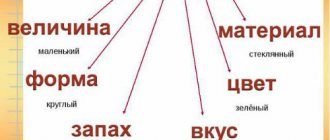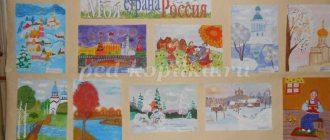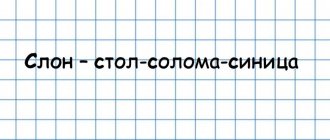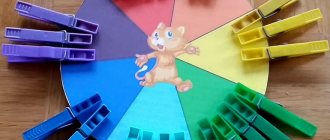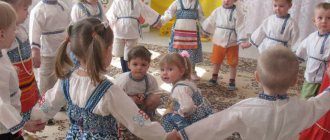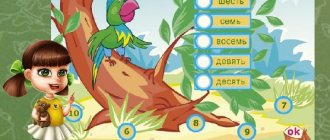Goals of didactic games in kindergarten
Didactic games contribute to the comprehensive development of a preschool child.
Their goals:
- formation of ideas about objects and phenomena of the surrounding world;
- consolidation of knowledge about flowers;
- familiarity with geometric objects;
- formation of ideas about right and wrong actions and actions;
- nurturing positive personal qualities, the ability to interact with others;
- familiarization with counting and numerical characteristics;
- development of memory, speech skills, concentration, ability to think logically;
- emotional and creative improvement, development of imagination;
- improvement of fine motor skills, general coordination and motor response;
- development of respiratory ability.
The concepts of “didactic game” and “didactic exercise”
Victoria Glavatskikh
The concepts of “didactic game” and “didactic exercise”
Article.
The concept of " didactic game "
and
"
didactic exercise " .
The didactic game is a multifaceted, complex pedagogical phenomenon; It is both a playful method of teaching children, a form of education, an independent play activity, and a means of developing various qualities, abilities, and skills in children.
The origins of the combination of teaching young children with play are in folk pedagogy. People created games such as “Ladushki”
,
“Magpie - white-sided”
,
“Ghouli - ghoul”
and many others.
A mother, playing with her child , teaches how to perform basic play actions. By naming parts of the body, objects or play actions, and gently saying, the mother lays the very first foundations of learning her native language and creates the joy of communication. K. D. Ushinsky highly valued the games lovingly created by the people for children. He pointed out that games, maternal refrains, nursery rhymes, jokes, little fairy tales contain accessible forms of learning, they are close to children in content, in play actions, images, and P. Usova, noting the educational influence of games, wrote: “Each game , if the child is capable of it, puts him in a position where his mind works vividly and energetically, his actions are organized.”
Folk pedagogy skillfully resolved the issue of the connection between learning and play and made a well-known contribution to understanding the characteristics of educational games. 1
Didactic games as a teaching method are presented in two types: games-activities and didactic , or autodidactic , games. The use of various components of gaming activity during game-activities alternates with questions, instructions, explanations, demonstrations. The basis of such games is the game plot and various game actions.
A didactic game as a form of education contains two principles: educational (cognitive)
and gaming
(entertaining)
.
The learning process takes on an emotional and cognitive character. Learning occurs in the process of active and intense play activities for children. A.P. Usova, assessing the didactic game and its role in the educational system, wrote: “ Didactic games , game tasks and techniques make it possible to increase the sensitivity of children, diversify the child’s educational activities, and add entertainment.”
A didactic game also acts as a means of developing individual qualities, abilities, and skills in a child.
In general, analyzing the works of Sorokina, Udaltsova, Avanesova, Bondarenko and others, we can consider such games as didactic that have a special educational and game structure. It highlights the following elements: didactic task , game task, game actions, game rules.
The didactic task is the first necessary element of an educational game and is aimed at communicating, consolidating, systematizing knowledge, mastering methods of action, forming children’s attitudes towards objects and phenomena of the surrounding life, and developing cognitive activity.
The next important component of the didactic game is the game task. V.N. Avanesova points out that an educational, cognitive task should be set for children through a game task that is close to the motives of children's play.
2
The didactic task is thus, as it were, disguised, hidden from the child. In these conditions, the relationship between children and adults is determined not by the educational situation (the teacher teaches, and the children learn from him), but by the game, by the fact that the teacher and children are primarily participants in the same game.
As soon as this principle is violated, that is, the playful nature of the relationship between the teacher and children disappears, the teacher takes the path of direct teaching, the didactic game ceases to be itself and falls into the category of exercises . To avoid this, each didactic game should present a detailed game action.
As noted in the works of F.N. Bleher, E.I. Udaltsova and other authors, a didactic game becomes a game due to the presence of game moments in it: expectation and surprise, elements of riddle, movement, competition, allocation of roles, etc. “If there are game action, didactic games take on the form of a game. The child’s attention is directed to the unfolding of the game action, and already during the game he unnoticedly performs the learning task. Game action creates children's interest in the didactic task of the game . Therefore, the more interesting the game action, the more successfully the children solve the learning task,” pointed out I. Udaltsova. It is important that the main stimulus of cognitive activity, the motive for performing a didactic task, is not the direct instruction of the teacher and the desire of the children to learn from him, but the natural desire for schoolchildren not to play , the desire to achieve the game goal, to win , this is what makes children perceive better, listen carefully, faster focus on the desired property, as required by the conditions and rules of the game, and thereby acquire the necessary knowledge and methods of action.
3
The basis for constructing a didactic game , the main tool to control the cognitive and play activities of children are the rules of the game. “Rules acquire a leading didactic meaning , through them the teacher directs the game along a given path, connects didactic and gaming tasks , organizes the behavior and relationships of children in the game. Without pre-established rules, the game action unfolds spontaneously and didactic goals may remain unfulfilled,” V. N. Avanesova pointed out the importance of the rules. The didactic purpose of the rules is carried out due to the fact that they represent a fairly precisely fixed method of action and develop in children the ability to self- and mutually organize.
Disclosure of the features of a didactic game , the playful nature of its various aspects, elements and links - the formulation and methods of solving educational problems, the motives and results of the child’s activities, the relationship between the teacher and children reveals the need to highlight another form of organized learning - didactic exercises Didactic exercises based on multiple reproduction, repetition, training in a particular action. The child gets the opportunity to act with specially developed didactic educational material. Learning here acquires a kind of educational and practical character, different from the direct educational influence in the classroom and the gaming influence in the didactic game . The inclusion of didactic games and exercises the didactic process of kindergarten, along with classes, significantly increases the effectiveness of learning, allows for a rational combination and change of activities, prevents fatigue and maintains high performance of children throughout the entire school period.
\
4
Based on the nature of the material used, didactic games are usually divided into games with objects and toys, board-printed and verbal. Games with objects and toys are most accessible to children, since they are based on direct perception and correspond to the child’s desire to act with things and thus become familiar with them. to play these games at an early age and does not lose his interest in them throughout all preschool age.
Printed board games, as well as games with objects, are based on the principle of visualization, but in these games children are not given the object itself, but its image.
The most complex are verbal games: they are not associated with the direct perception of an object; in them, children must operate with ideas. These games are of great importance for the development of a child’s thinking, because in them children learn to express independent judgments, draw conclusions and conclusions, and notice logical errors. Consequently, these games develop the ability to listen carefully, quickly find the right answer to a question, accurately and clearly formulate your thoughts, and apply previously acquired knowledge.
Thus, a didactic game as a means of learning ensures the formation of new and consolidation of existing knowledge, teaches children to use the acquired knowledge in various conditions, promotes the development of independence and activity of thinking. Consideration of the didactic game of the phenomenon of organized learning, as one of the forms of organizing education in kindergarten, presupposes the presence and the relationship between its following components: didactic , game task and game action, rules.
5
Bibliography.
1. Usova A.P. Education in kindergarten. Ed. A.V. Zaporozhets. M., Education, 1981
2. Udaltsova E.I. Didactic games in the education and training of preschoolers. Minsk, 1976
3. Udaltsov B.I. Didactic games . M. ;Uchpedgiz, 1963
4. Lyurikova I., The role of didactic games and exercises in the formation of grammatically correct speech in children. Preschool education - 1988 No. 2
5. Tyurikova I. The role of didactic games and exercises in the formation of grammatically correct speech in children. Preschool education - 1988 No. 3
Didactic games for the younger group of kindergarten
At the age of 2-3, children actively get acquainted with the world around them and learn basic concepts. Didactic games for this age group are simple and involve one action. Group games are recommended; they teach kids to follow collective rules, develop communication and interaction skills to achieve goals.
Find a couple
For the game, prepare pictures of mittens and hats in 4 colors: green, red, yellow, blue.
Tell the children that the dolls are going for a walk. They have already put on their hats, but they can’t find mittens of the same color, they need help. Arrange the pictures chaotically on the table. The players' task is to find mittens that match the color of each hat.
Several people can play, each selecting their own 4 pairs. In this case, you can organize a competitive game: the first one to match all 4 pairs of mittens to the hats wins.
listen carefully
Give each student a flag. Play music or, if you are musically inclined, play an instrument. When the music is low, children should sit quietly with the flag down. And when the music starts playing loudly, the students raise a flag above their heads and wave it.
Make beads
For the game, prepare laces and beads of 4 colors: red, blue, green, yellow.
Tell the students that the dolls have gathered for the name day, but they have nothing to decorate themselves with. Offer to make beads, show the children laces and a box of colorful beads. The task is to select beads of a certain color from a box and attach them to a cord of a similar color.
The game can be competitive. 4 children play, each making beads of a given color. The one who finishes it faster than the rest becomes the winner.
Find your match
To play, make cardboard geometric shapes in different colors. Distribute the pieces in pairs according to the number of players.
Place the cards in a box and ask the children to take them out one at a time. Let the players look at the pieces, then find the same one from a friend. You can repeat the action many times. You can complicate it by dividing geometric shapes not only by color, but also by size.
Collect a picture
Prepare pictures for the game depicting objects familiar to preschoolers, cut them into 4 parts. Also place real objects in front of the children that match the pictures.
The players' task is to collect the picture. The player who completes the task correlates the resulting image with a real object. The winner is the one who first collects the picture and correctly points to the object corresponding to it.
Bad or good deed
Print out pictures with positive and negative stories for the game. Let the students look at the images and evaluate the actions of the characters. For example: “The boy pulled the girl’s pigtail. The girl began to cry. He did something bad."
Butterflies are flying
To play, cut out 5 butterflies from colored paper. Tie each one with a 50 cm thread. And secure the thread to a rope stretched horizontally. The distance between the figures should be approximately 40 cm, and their height should correspond to the eye level of the preschooler.
Tell them that butterflies fly beautifully. Blow on one of them, ask the students to do the same. Children take turns standing near the paper figures and blowing on them. The game is competitive, the one whose butterfly flies farthest wins. Make sure that players keep their back straight, do not tense their shoulders when exhaling, and do not puff out their cheeks. Each player exhales once, and it should last no more than 10 seconds, otherwise dizziness may begin.
Progress of the game
There are several options for exciting didactic games on the topic “Toys”.
Dollhouse
To play, you need to make a doll's house and pieces of furniture from scrap materials. The activity develops creative thinking, with its help children learn where what furniture should be in the home, learn to behave correctly in the house, and consolidate knowledge about sides and angles.
Pupils look at the doll's house, arrange the furniture in the way they think is most correct and comfortable. At the same time, they say, for example, “the closet should be in the left corner of the bedroom on the second floor,” let’s put the dining table in . The teacher simultaneously asks why the children chose this arrangement and why they think it is correct.
Dress up the doll
In the younger group, you can play a competitive game, take two or more dolls of the same size with similar clothes. There are as many players as there are dolls. The rest of the children cheer for their playing classmates.
The game, depending on the number of dolls, can be played in pairs, or in several rounds with elimination. The most dexterous one wins.
Fix the toy
The teacher prepares pictures depicting different toys. Cuts into several parts. The players’ task is to “fix” the image and connect its parts.
Find the shadow
To play the game, you need to prepare pictures depicting different toy objects, and pictures with similar silhouettes of these objects. The players' task is to make pairs of pictures.
Pick up a toy
The teacher shows the children geometric shapes - circle, oval, square, rectangle, triangle. During the didactic game, the players try to determine which toy is similar to each of the figures.
Who's wearing what?
For the didactic game “Toys” in the younger group, you need to take several dolls that differ in clothing and appearance. Having arranged them, the teacher asks “who has a red sundress,” “who has white socks,” “who has blond hair,” “who has blue eyes,” and so on. Children point to the corresponding dolls.
What disappeared
The following game is suitable for the average group of preschoolers: the teacher puts several toys on the table, the children remember them and close their eyes. The teacher removes one item. Children, opening their eyes, try to remember which object disappeared.
Who wants what?
The teacher puts three balls of different sizes, next to them puts three dolls (or three cars, or three teddy bears), also different in size. The task is to distribute objects in pairs and determine how they compare in size.
Similarly, you can distribute objects by color. For example, take red, yellow, blue balls and dolls in similar colored dresses.
Describe the toy
For playing in the older group, the teacher chooses several toys that differ in appearance. Children are divided into groups. Participants take turns naming a feature that characterizes the object chosen by their group.
For example:
- doll - beautiful, large, fair-haired, elegant, smiling, blue-eyed;
- teddy bear - teddy, brown, soft, kind, cute, cheerful;
- The machine is plastic, small, fast, smooth, shiny.
The group that names the most features wins. The game develops the ability to match adjectives to nouns.
Didactic games for the middle group of kindergarten
For preschoolers aged 3-4 years, didactic games are a way to expand their individual vocabulary and familiarize themselves with the objects of the surrounding world. Children learn the parameters and characteristics of objects, learn classification and comparison, and consolidate previously acquired knowledge.
When does this happen
For the game, prepare pictures with scenes from the daily life of a preschooler and place them in front of the students. When you say “morning,” children should look for images that correspond to that time of day, for example, brushing their teeth, doing exercises, combing their hair. Players who pick up the correct picture receive a point. The player with the most points wins.
Does this happen?
Say phrases relating to objects and phenomena of the seasons, and the students must say whether this happens. For example: “On a hot summer day, we left the house with a sled to go down the hill.” Or: “In the spring, birds began to gather in flocks to fly to the southern regions.”
What can you do in this place
Ask a question about a certain place, and the children must say what can be done there. For example: “On the river you can... swim, sunbathe, build sand castles, fish, ride a boat.” Or: “In the garden you can... weed the beds, water the plants, harvest the crops, set up a scarecrow.”
Name the signs
Say the words, and the children should take turns naming their signs. For example: a fox is red, cunning, beautiful, dexterous, tailed, fluffy. Or: the house is tall, brick, wooden, new, destroyed, spacious.
What does it sound like
For the game, prepare several boxes with different contents: sand, turf, grain, beans, pebbles. Demonstrate to the students what different substances sound like: shake each box. Then mix them up and, without showing the contents to the children, shake them again. Players must guess by the sound what substance is inside.
Shop
Organize an impromptu store, lay out various toys on the counter. Explain to children that they can buy a toy when they do not name it, but describe its features. Moreover, when describing, you cannot look at the item, so as not to give the seller a guess. The seller must, based on the signs presented, guess what kind of toy we are talking about and give it to the buyer. For example, a buyer says: “I need a round, bouncy, rubber toy.” The seller selects a ball.
Hide and seek
Organize a game on the kindergarten playground if there are a lot of trees and shrubs of different types. Or take your students to a city park.
Children choose who will search and hide behind trees and bushes. Your task is to guide the seeker, suggest where to look, without naming the type of plant. For example: “Find the one who hid behind a tall tree with a hollow and carved leaves.”
Name the action
Ask questions, and students must answer with verbs. The player who answers correctly receives a point. The one who collects the most points wins. For example: “What does the teacher do? - teaches a lesson, checks notebooks, educates, grades, writes on the board.” Or: “What can you do in the kitchen? “cook soup, peel potatoes, make tea, have lunch, wash dishes, bake pies.”
Board and printed games as a means of developing the attention of children of senior preschool age
The article reveals the relevance of the problem of attention development in older preschool age and the possibility of using printed board games as a means of conditioning its development.
Key words: attention, senior preschool age, didactic game, volume, distribution, switching, stability
The relevance of the problem of studying attention is due to the fact that this mental process is a condition for the successful implementation of any activity of children, both external and internal, and its product is its high-quality implementation [5].
The works of domestic and foreign researchers L. S. Vygotsky, P. Ya. Galperin, N. F. Dobrynin, L. N. Leontyev, T. Ribot, S. L. Rubinstein and others are devoted to the study of attention.
An important feature of attention is that it ensures selectivity of the course of mental processes and is a form of organization of cognitive activity. At the same time, attention itself is not an independent process; it is part of other processes and does not have its own content [4].
According to L. S. Vygotsky, attention is a mental state that characterizes the intensity of cognitive activity and is expressed in its concentration on a relatively narrow area (actions, object, phenomenon) [3].
In preschool age, attention has a number of specific features, knowledge of which is important for organizing the educational process with children.
In children of senior preschool age, attention is still very unstable, since it does not have internal means of self-regulation. L. S. Vygotsky noted that the most important prerequisite for the development of attention in older preschool age is the development of speech in children. The use of language as a means of directing attention and a pointer to the creator of ideas is important for pedagogy [3].
The author points out that initially the processes of attention are directed by the speech of an adult and for the older preschooler they act more like processes of external discipline than self-regulation. At this age, an elementary form of voluntary attention appears under the influence of self-instructions, and sometimes with the support of external aids. Gradually using the usual means of mastering attention in relation to oneself, a child of senior preschool age comes to self-control of behavior, that is, to voluntary attention.
N.V. Lyaudis believes that the development of attention during preschool age comes from achieving the goal set by an adult to the controlled solution of problems set by the child himself [5].
In older preschool age, in general, attention and its qualitative characteristics are more developed than in comparison with younger children. At the same time, L.I. Baskakova emphasizes, the development of externally mediated attention proceeds much faster than the development of attention in general, especially natural attention. In older preschool age, a certain turning point in development occurs, which is characterized by the fact that externally mediated attention gradually begins to turn into internally mediated, and over time, this form of attention takes the main place among its other types [1].
F.N. Gonobolin believes that the attention of a child of senior preschool age is relatively long-lasting and stable, which is manifested in his activities. The child has acquired some experience in managing his attention and organizing it independently. Volume and stability, switchability and concentration of attention increase towards the end of senior preschool age. However, even here the child’s attention still retains some signs of “childhood.” Children's attention reveals its most perfect features only when the object or phenomenon that directly attracted attention is especially interesting for the child. All properties of attention to older preschool age are actively developing [4].
As many researchers note, attention acquires certain qualities depending on the activity in which it is manifested and formed, depending on how this activity is managed.
It is possible to develop attention in the process of directing attention in classes, exercises, and didactic games.
The works of A.K. Bondarenko and D.V. Mendzheritskaya note the advisability of using didactic games in teaching preschool children. [2,6].
Didactic games are a type of games with rules, specially created by pedagogy for the purpose of teaching and raising children. They are aimed at solving specific problems of teaching children, but at the same time, they demonstrate the educational and developmental influence of gaming activities.
Among the variety of didactic games used in preschool age, a special place belongs to board and printed games.
Printed board games are a type of didactic games that are games with rules on a printed basis.
Board and printed games are aimed at clarifying ideas about the environment and systematizing knowledge. They contribute to the development of intelligence, attention to one’s own actions, to the actions of a friend, orientation in the changing conditions of the game, the ability to foresee the results of one’s move, and the development of mental operations.
As A.K. Bondarenko and D.V. Mendzheritskaya note, board and printed games are varied in their types. These include: a variety of educational games, pictures (paired pictures, cut-out pictures), puzzles, subject lotto, dominoes, themed games (where what grows, when does it happen, who needs it), etc. Games that require motor activity and skills (flying caps, hit the target, jib), games such as mosaics [2,6].
The main difference between board games and other types of games is that they are played at a table. These games have several participants, certain game rules and game actions.
Printed board games can be effectively used to develop attention, as they help children concentrate, ensure switching and distribution of attention, and develop attention span. Let us describe these possibilities in more detail.
The scope of attention reflects the number of objects that the child perceives simultaneously. In accordance with this, the development of attention span will be facilitated by a gradual increase in the number of objects that the child simultaneously perceives in the game.
When using board-printed games, variants of games that can contribute to the development of volume can be games on: classification, on building a logical series, on grouping pictures according to some characteristic, on searching for an extra object depicted in the picture, etc. .
In order to develop the span of attention, it is necessary to take into account at what level the span of attention is already developed in the child in order to initially offer him board-printed games in which the number of pictures perceived at the same time will not significantly exceed his formed memory capacity. Because this can lead to the child’s failure to complete the task, and a decrease in his motivation to complete such tasks and participate in games. In addition, we believe that the development of attention span in printed board games can be facilitated by the participation of several participants, such as in lotto, dominoes or in games in which children select pictures in micro groups of 3-4 people. When an older preschooler participates in a game with other children, he finds himself in conditions in which he needs to track and keep in the field of attention the actions that a peer is performing, track the order of moves in order not to miss his move, analyze the correctness of the peer’s choice or another picture, in order to prevent a possible mistake, and to implement competitive motivation, to strive to achieve the required result faster in the game [1].
The main principles for the development of attention span in board games can be: the principle of gradually increasing the number of simultaneously perceived objects, the organization of board games in pairs and microgroups, and the use of competitive elements.
Sustainability of attention presupposes a general focus on the activity that the child is performing, that is, the ability to maintain attention throughout the entire game. In order to develop stability of attention, you can offer children printed board games that vary in the duration of the game actions. For example, a game may offer a child one or two tasks, or three tasks. A game, such as dominoes and lotto, can also have several series of games [1].
The key condition for moving to another level of game duration is for teachers to assess how the child is already coping with this game, whether he can maintain attention throughout the game. If the child copes with this, then the duration of the game can be gradually increased. It must be remembered that the monotony of the game, a rare change of actions or pictures can lead to decreased interest, distraction and increased fatigue.
The basic principles for developing stability of attention in board-print games in older preschoolers may include: the principle of gradually increasing the duration of the game, increasing the complexity of the game action, when the child, for example, needs to perform analysis or comparison, which requires maintaining attention on the object. It also prevents the monotony of the game.
Distribution of attention reflects the child’s ability to distribute his attention between different objects. For example, in the game “Dominoes”, a child needs to simultaneously monitor the game actions of the participants and the pictures he has in order to correlate them with the picture depicted as a result of the last move of another participant [1].
In the development of distribution skills, training is also important, in which it is necessary to gradually increase the complexity of board and printed games in terms of content. At first, it is advisable to offer games of simpler content, where the child needs to perform simple actions and monitor them. Gradually, by complicating the content of the games itself, as well as increasing the number of participants in the game, one can contribute to the development of distribution [1].
The main principles for developing the distribution of attention in an outdoor game can be: the principle of gradually complicating the game, the principle of increasing the number of participants in the game.
Switchability is the ability to maintain attention when changing activities or when changing game material, so that attention remains productive. To develop switching attention in board and printed games, it is important that the game involves a change of game material, that is, cards, a change of moves, a change of participants, when the game, for example, is carried out in several series so that as many children as possible can play it .
The principles for developing attention switching in board and printed games are close to the principles for developing other properties. In this case, we believe that the greatest importance is a gradual increase in the complexity of game actions, the selection of games that provide for changing game cards, and a change of participants in order to involuntarily stimulate the child to switch attention.
Thus, having considered the possibilities of board and printed games in the development of attention and its properties, we can conclude that these possibilities are quite wide.
It is important to competently use the conditions for its development in board and printed games, through the implementation of the principles of work we have outlined, the selection of game material, and the methodology for organizing the game itself.
Literature:
- Baskakova, I. I. Attention of a preschooler, methods of study and development [Text] / I. I. Baskakova. - M.: Publishing house "Institute of Practical Psychology", Voronezh: NPO "MODEK", 2005. - 64 p.
- Bondarenko, A.K. Didactic games in kindergarten [Text] / A.K. Bondarenko. - M., 2011. - 175 p.
- Vygotsky, L. S. Psychology of child development [Text] / L. S. Vygotsky. — M.: Meaning. 2004–512 pp.
- Gonobolin, F. N. Attention and its education [Text] / F. N. Gonobolin. M.: Pedagogy, 2012. - 56 p.
- Lyaudis, N.V. Attention in the process of development [Text] / N.V. Lyaudis. - M.: Vlados, 2011. - 145 p.
- Mendzheritskaya, D.V. To the teacher about children's play [Text] / D.V. Mendzheritskaya. - M., 2008. - 128 p.
Didactic games for the senior group of kindergarten
Didactic games, intended for preschoolers 5-6 years of age, involve the completion of complex tasks and the formation of correct relationships. In this age group, the educational and developmental process is built in the form of basic classes, and through games, children consolidate acquired knowledge and skills. The competitive process plays a significant role, promoting proper emotional development and establishing positive contact with other people.
Find the ball and name the color
Children stand in a circle. Stand in the center, throw the ball to each player in turn, and call a specific color. The player's task is to name the object with the appropriate color, then throw the ball back. For example: orange - orange, apricot, carrot. Or: purple - eggplant, plum, grapes, lilac.
Generalization
The players stand in a row. Throw a ball to each of them in turn, after naming a generalizing concept. Children must name objects that correspond to the generalization. For example: fruits - apple, orange, peach, pear, apricot, lemon.
Complete the drawing
To play, print out cards depicting shapes that can become part of an object. Laminate the images so that you can draw on them with erasable markers.
Show the children the cards and ask them what the shapes look like. Hand out the pictures to the players so that they can fill in what they represent. Then erase the images, change cards between players. And so on until each child has fantasized about all the figures.
Remember and find
The game should be organized in a spacious room in which kindergarteners can navigate well. Place any toys on the floor. Ask the player to look at them carefully and remember the location. Then blindfold the child with a scarf. The game task is to blindly find objects laid out on the floor.
Columbus egg
To play, print out the egg template, then cut along the lines into 10 shapes. From these figures you can create a variety of silhouette images. This activity is extremely fascinating for preschoolers and develops their imagination.
Who will collect the items faster?
The game is competitive. For her, prepare cards depicting objects that relate to different professions. For each player, or for a group of players if there are many children, determine a profession. The game's task is to find three pictures in a pile that relate to a given profession faster than others. For example: cook - cap, pan, ladle. Or: doctor - white coat, thermometer, syringe. Or: seamstress - thread, scissors, sewing machine. Or: builder - helmet, drill, trowel.
Complete the drawing
Give the players pictures of objects with missing parts, for example, a dog without a tail, a house without windows, a car without wheels. Children must say what is missing in the picture and complete this part.
Didactic games on the topic "Toys" material on the world around us (senior group) on the topic
Didactic games on the lexical topic “Toys” in the senior group
1. “What is missing”
Goals:
- Enrichment of vocabulary on the topic.
- Development of visual attention.
Toys (up to 5) are displayed on the table. The children, together with the teacher, look at them and name each toy. Then the teacher invites the children to close their eyes and removes one toy. Then the children open their eyes and name the toy that is not on the table.
2. “Who has what toy?”
Goals:
- Comparison of toys by size.
- Activation of the dictionary.
Children are offered three balls of different sizes (large, smaller and the smallest), three bears (matryoshka dolls, dolls, cars) also different in size. It is necessary to find the owner for each ball, correlating the toys by size.
3. “Find a match”
Goals:
- Comparison of toys by color.
- Formation of the ability to coordinate adjectives with nouns in gender.
The game involves paired pictures depicting toys of the same color. The game is played like Lotto. The child needs to find a match for his picture.
4. “What toy is missing?”
Goals:
- Development of the ability to compare toys by color and shape.
- Education of visual attention.
- Activation of the dictionary.
Children are offered a table of 9 cells, 8 of them contain images of three different toys or the same, but three different colors. One cell is empty. The child, together with the teacher, establishes the pattern of arrangement of toys in the cages and determines which toy is missing.
5. "What's Hidden Here"
Goals:
- Development of imagination.
- Activation of the dictionary on the topic.
Children are offered geometric shapes - circle, square, oval, triangle. Children determine what toys these figures resemble.
Didactic games on the topic: CLOTHING
1. “Dress Tanya, dress Vanya”
Goals:
- Development of visual attention and logical thinking.
- Activation of the dictionary on the topic.
- Fixing the names of colors.
On small cards (10 pieces) there are images of clothes for girls and boys. Children, together with the teacher, look at the cards and name each item of clothing. Then, on a large field, cards are laid out according to the image of a girl or a boy. Find out what clothes everyone can wear.
2. “Choose clothes for the nesting dolls”
Goals:
- Development of visual attention.
- Fixing the names of colors.
- Agreement of adjectives and nouns in gender and number.
On a large canvas there is an image of nesting dolls in yellow, blue, red and green. The small cards show a sundress, a scarf, an apron, and socks for each nesting doll. Children are asked to choose clothes of the appropriate color for each nesting doll.
3. "Who's wearing what"
Goals:
- Development of visual attention and the ability to listen to a question and answer it in one word.
An adult asks a question like: Who is wearing white tights today? Who's wearing a denim sundress? And so on.
4. “Mishka and Mishutka”
Goals:
- Development of the ability to compare objects by size.
- Education of visual attention.
- Activation of the dictionary.
- Formation of the diminutive form of nouns
Children are offered small and large bear toys or their images. The small cards show a shirt and a shirt, shorts and shorts, a hat and cap, a scarf and a scarf, socks and socks. You need to “dress” the toys, naming what is for whom. For example: We will put on a shirt for Mishka, and a shirt for Mishutka.
Preparatory group
In the preparatory group, preschoolers prepare for the transition to first grade and acquire important knowledge and skills. Therefore, complex didactic games with a predominantly educational focus are applicable.
Train for animals
To play, make a cardboard train with 3 carriages: the first for animals, the second for birds, the third for insects. Print out pictures depicting fauna representatives. The game task is to correctly arrange the pictures into the cars.
Man or nature
Children stand in a circle. Throw a ball to each of them in turn, asking at random, “What did the person do?” or “What has nature done?” In the first case, the answers will be, for example, “car”, “clothes”. And in the second there is “tree”, “river”, “stone”, “nest”. The player who finds it difficult to answer is eliminated from the circle. The winner is the last one to give the correct answer.
Name the plant
Say a sound and the players must remember the plants that start with it. For example: A – aster, watermelon, orange, pineapple, aloe, acacia, cherry plum.
Clouds
On a fine day, when cumulus clouds float in the sky, take the students for a walk. Let everyone choose a cloud and tell them what it reminds them of.

